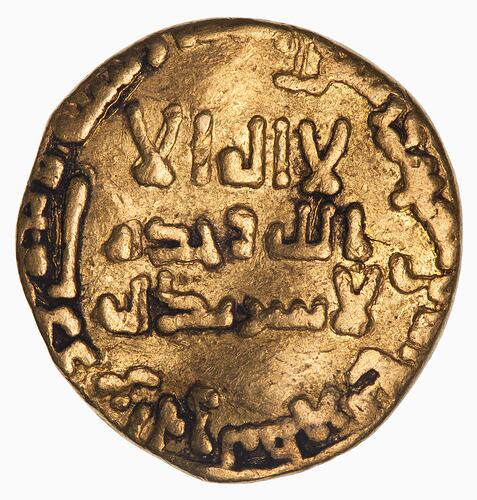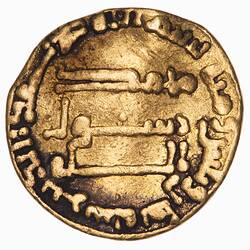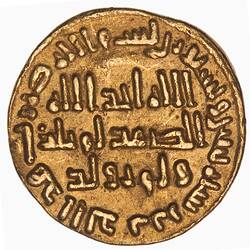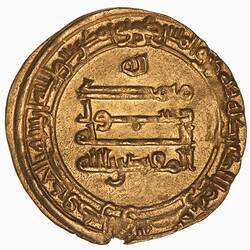Summary
Dinar coin issued by the Abassid Caliph al-Mansur (754-775 AD). Struck at the Damascus mint (probable) in the year 138 AH (755-756 AD). The coinage reform which led to the issue of this coin began in 77 AH (696-697 AD) under the Umayyad Caliph 'Abd al-Malik. It removed all symbolism associated with Byzantine or Sassanian rule. Instead a purely inscriptional coin-type, giving in Arabic ( script and language) the Muslim confession of faith, and various Qur'anic verses were employed. On gold coins the date is of production is provided but, during the early years of the Abbasid Caliphate, usually not the name of the mint, it is believed that Damascus was the normal gold mint.
Obverse Description
At centre Arabic legend (Kufic script) in three lines (translation: There is no deity except God alone, He has no equal); around Arabic legend (translation: Muhammad is the prophet of God sent with guidance and the religion of truth to make it prevail over all religion, averse although idolaters may be - source: Codrington p.23)
Reverse Description
At centre Arabic legend (Kufic script) in three lines (translation: Mohammad is the messenger of Allah - source: Plant p.44); around Arabic legend (translation: In the Name of Allah this dinar was struck in the year eight and thirty and one hundred)
Edge Description
Plain
More Information
-
Collecting Areas
-
Acquisition Information
Purchase from Spink (Australia), 10 May 1982
-
Date Issued
138 AH
-
Issued By
-
Mint
-
Denomination
-
Material
gold
-
Axis
04
-
Classification
-
Category
-
Discipline
-
Type of item
-
Dimensions
19 mm (Outside Diameter), 3.972 g (Weight)
-
Exhibition Collection Management
19 mm (Width)
-
Shape
Round
-
References
cf BMC 10 but Year 138
[Book] Poole, Stanley L. 1875. Catalogue of Oriental Coins in the British Museum. I., 37 Pages
[Book] Plant, Richard J. Arabic Coins and how to read them., 44 Pages
[Book] Codrington, O. 1904. A Manual of Musalman Numismatics., 23 Pages





